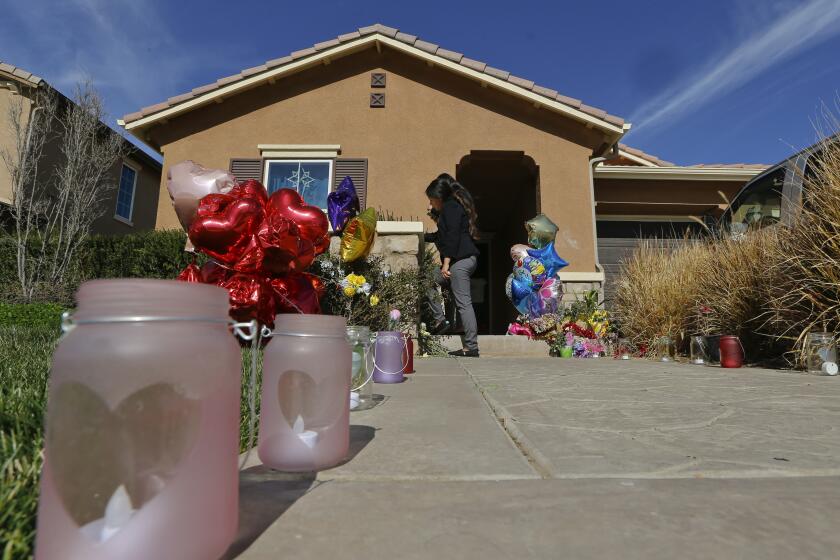THE FIGHT AGAINST CRIME: NOTES FROM THE FRONT : A Hard-Core Bicyclist Takes Some Lumps
The worst segment of the 150,000 miles of cycling that Bob Winning has logged was the 20 or so feet he skidded on his back on Topanga Canyon Boulevard in Chatsworth three weeks ago.
He didn’t hit anything, and nothing hit him, besides the asphalt. In fact, the motorist who caused the chain of events that sent Winning tumbling said later that she saw him quite clearly.
She just didn’t realize bicyclists in San Fernando Valley, especially gung-ho pedalers like Winning, often travel at speeds of 25 miles per hour or more. She turned across his path to get into a produce stand. Winning hit the brakes. Then Winning hit the pavement, forehead first.
“I destroyed my helmet,” he said. “I had a fractured right thumb, sprained ankle, back abrasions, and my shoulder muscles were so strained I had to lie in bed. . . . I had to get plastic surgery on my face.”
Winning isn’t sore, at least not at the motorist. She stopped, and was as apologetic as she was uninsured. Winning, who recently published a book on cycling in Los Angeles, chalks it up as another chapter in the unending saga of bicyclists versus cars in the San Fernando Valley. Like Winning, cyclists are losing this one.
“A car versus a bike? A bike is going to lose, no doubt about it,” said Sgt. John Amott of the Los Angeles Police Department’s Valley traffic unit.
Plenty of motorists make the same mistake that sent Winning flying, said Amott.
“I’ve written people up for turning left in front of a bike or pulling out of a stop sign,” he said. “They can’t believe it. They don’t understand it.”
Lest motorists think they are getting a bum rap, Amott says officers give more tickets to cyclists for disobeying traffic laws than to cars for endangering cyclists.
The basic principles of bicycle-motorist etiquette are not complex: “The vehicle code says that the laws that apply to bicycles are the same as the ones that apply to cars,” said Amott.
That means bicyclists have to ride in the same direction as traffic. They can’t even ride in a crosswalk if it is against the flow of traffic. Above all, they are supposed to stop at stop signs and red lights.
There’s the rub that rubs motorists the wrong way. If plenty of cars roll through stop signs without halting, it’s no surprise that bicyclists admit to being frequent offenders.
Traffic officers have gone out to Valley Circle Boulevard on weekend mornings to await large packs of racers who speed through red lights or stop signs. As many as 12 at a time have gotten citations for it, said Amott.
It’s not just racers, or youngsters, for that matter. Pete Held is 58. He rides 13,000 miles a year. And he’s gotten tickets along the way. “I’ve gotten about four of them, for running stop signs, all of them guilty as charged,” he acknowledged. “Most cyclists run stop signs regularly and red lights occasionally. . . . I see it across the spectrum from racers to kids.”
Richard Flores, a racer with Team Cycle World in Northridge, trains with a large pack of riders. He and fellow racers have run their share of stop signs in the 200-300 miles they average weekly. Most are in areas with light traffic, and lead riders always caution those behind them before committing the pack, he said.
Running stop signs may be illegal, Flores said, but it doesn’t give motorists the right to vehicular vengeance.
“The worst you see is a driver getting aggressive with a pack of riders,” Flores said. “He’ll try to pass and either spook oncoming traffic, spook the pack or cut back in front of the pack too early.”
When there is no bicycle lane, riding in a pack is perfectly legal, according to traffic police.
Racers will move over when they can, but won’t if it means a motorist will fly by with only inches to spare, said Flores.
“It’s a matter of common sense,” he said. “Common sense on the part of the bicyclists and common sense on the part of the cars.”
Sometimes, however, the law of averages prevails over the rule of common sense.
“I think the California drivers are the best in the world,” Held noted. “But there are a lot of them, and statistically, you’re going to get in trouble with one of them some time.”
More to Read
Sign up for Essential California
The most important California stories and recommendations in your inbox every morning.
You may occasionally receive promotional content from the Los Angeles Times.










